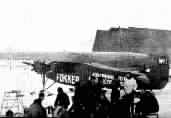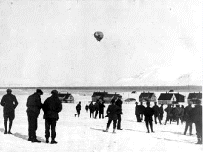|
|
|
|
|
|
|
|
|
|
|
|
|
|
|
|
|
|
|
|
|
|
|
|
|
|
|
|
|
|
|
|
|
|
|
|
|
|
|
|
|
|
|
|
|
|
|
|
|
|
|
|
|
|
|
|
|
|
|
|
|
|
|
|
|
 |
 |
 |
 |
 |
 |
 |
 |
 |
 |
 |
 |
 |
 |
 |
 |
 |
|
|
|
 |
 |
 |
| APPENDIX D |
|
| CHRONOLOGY OF |
| NORTH POLAR EXPLORATION |
 |
|
 |
 |
 |
 |
 |
 |
 |
 |
|
|
 |
 |
 |
 |
|
 |
 |
 |
 |
 |
 |
 |
 |
 |
 |
 |
 |
 |
 |
 |
 |
 |
 |
 |
 |
 |
|
|
 |
 |
 |
 |
 |
 |
 |
 |
 |
 |
 |
 |
 |
 |
 |
 |
 |
 |
 |
 |
 |
 |
 |
 |
 |
 |
 |
 |
 |
 |
 |
 |
 |
|
 |
 |
 |
 |
 |
 |
 |
 |
 |
|
|
|
 |
 |
 |
| By the late 1800s, long-held dreams of discovering a northern sea-route to the Far East had failed to materialize. What instead ensued in the far north was a race among various nations and personalities to set record northings and, ultimately, to reach the pole itself. The following are the established Farthest Norths. |
| See map below for location of circumpolar lands. |
|
| 1871 82º11' N Charles Francis Hall, American, in the ship Polaris, via the |
| Smith Sound route between Greenland and Ellesmere Island. |
| 1876 83º20'N Lt. Albert H. Markham, British, by dogsled, from the ship HMS |
| Alert on the north coast of Ellesmere Island. |
| 1882 83º24'N Greely/Lady Franklin Bay Expedition, American, by dogsled, |
| from the north coast of Ellesmere Island. |
| 1895 86º13'N Fritjof Nansen and Hjalmar Johansen, Norwegian, by dogsled, |
| from the ship Fram at 84ºN in the polar sea and returning to Franz Josef |
| Land. |
| 1900 86º34'N Capt. Umberto Cagni, Italian, of the Duke d'Abruzzi expedition, |
| by dogsled, from Franz Josef Land. |
| 1906 87º6' N Robert E. Peary, American, by dogsled, from the north coast of |
| Ellesmere Island, claimed, considered questionable. |
| 1908 90ºN Frederick A. Cook, American, by dogsled, from the northern tip |
| of Axel Heiberg Island, claimed, unverifiable. |
| 1909 90ºN Robert E. Peary, American, by dogsled, from the north coast of |
| Ellesmere Island, claimed, unverifiable. |
| 1925 87º44'N Roald Amundsen, Norwegian, and Lincoln Ellsworth, |
| American, by airplane, from Kings Bay, Spitsbergen. Ellsworth's plane |
| landed on the ice at 87º44'N and Amundsen's at 87º43'N, as verified by |
| sextant observation and confirmed by observers. Since neither Cook's |
| nor Peary's claims could be verified, this may have been a record farthest |
| north to date that was not exceeded until the 1937 SP-1 expedition, |
| Russian, from Franz Josef Land, landed on the ice in the near vicinity of |
| the North Pole |
 |
|
|
 |
 |
 |
 |
 |
|
 |
 |
 |
 |
 |
 |
 |
 |
 |
 |
|
|
|
 |
 |
 |
| WHO WAS FIRST AT THE NORTH POLE? |
| ~ Some Accepted and Some Disputed Records ~ |
 |
|
|
 |
 |
|
 |
 |
 |
 |
|
|
|
 |
 |
 |
| 1908 FREDERICK A. COOK, American, by dogsled, from the northern tip of Axel Heiberg Island. This claim was debunked and Cook disgraced for most of the twentieth century. However, it may have some validity. In the light of recent findings, many Arctic historians and scientists are reconsidering Cook's claim. |
|
| Photo: Frederick A. Cook Society |
 |
|
|
|
 |
 |
 |
|
|
|
 |
 |
 |
| 1909 ROBERT E. PEARY, American, by dogsled, from the north coast of Ellesmere Island. This claim was accepted for much of the twentieth century although there were many detractors. History books and encyclopedias tend to continue to credit Peary with being the first to reach the North Pole, but today the claim that Peary actually reached the vicinity of the pole is considered highly questionable. |
| Photo: Peary in arctic furs. |
 |
|
 |
 |
 |
 |
 |
 |
|
|
|
 |
 |
 |
 |
 |
 |
|
 |
|
|
|
 |
 |
 |
| 1926 RICHARD E. BYRD, American, in the tri-motor airplane Josephine Ford from Kings Bay, Spitsbergen. This claim of being the first to fly to the North Pole was in serious doubt from the very beginning, particularly among aviators. It is now largely discredited. Note also, that Byrd never claimed to have landed at the North Pole |
 |
|
|
 |
 |
 |
|
|
|
 |
 |
 |
| Photo: The Josephine Ford , Kings Bay, Spitsbergen, 1926. The Norge hangar is in the background. |
 |
|
|
 |
 |
 |
 |
 |
 |
 |
 |
 |
 |
 |
 |
 |
 |
 |
 |
 |
 |
 |
 |
 |
 |
 |
 |
 |
 |
 |
 |
 |
 |
 |
 |
 |
 |
 |
 |
 |
 |
 |
 |
 |
 |
 |
|
 |
|
|
|
 |
 |
 |
| 1926 AMUNDSEN-ELLSWORTH-NOBILE EXPEDITION, joint American, Norwegian, Italian, in the airship Norge, from Kings Bay, Spitsbergen to Teller, Alaska by way of the North Pole. First undisputed attainment of the North Pole and first undisputed attainment of the North Pole by air. Note, however, that the Norge over-flew but did not land at the North Pole. |
| Photo: The airship Norge airborne departing Kings Bay, Spitsbergen on its trans-polar flight, 1926. |
 |
|
|
|
 |
 |
 |
 |
 |
 |
 |
 |
 |
 |
 |
 |
 |
 |
 |
 |
 |
 |
 |
 |
 |
 |
 |
 |
 |
 |
 |
 |
 |
|
|
|
 |
 |
 |
| 1937 SP-1 EXPEDITION, Russian, led by Russian Arctic scientist Otto Schmidt, Georgi Vodopyanov, pilot, in ski-equipped Russian-built 4-engine airplane, from Franz Josef Land. First airplane landing on the ice in the near vicinity of the North Pole. |
|
| Photo: Professor Otto Schmidt, leader of the SP-1 Expedition that established the first floating polar ice station in the Arctic Ocean, in the vicinity of the North Pole, 1937. |
 |
|
 |
 |
 |
|
|
|
 |
 |
 |
|
|
|
 |
 |
 |
| 1958 USS NAUTILUS, nuclear submarine, American, from the direction of Pt Barrow, Alaska to the Greenland Sea between Greenland and Spitsbergen, by way of the North Pole. First submarine to travel under the polar ice pack and cross the North Pole. Note: the Nautilus did not surface at the North Pole. |
| Photo: U.S. Navy photo of the Nautilus at sea. |
 |
|
 |
 |
 |
 |
 |
|
|
|
 |
 |
 |
 |
 |
 |
 |
 |
 |
 |
 |
 |
 |
 |
 |
 |
 |
 |
 |
 |
 |
 |
 |
|
|
|
 |
 |
 |
| 1968 RALPH PLAISTED EXPEDITION, American, by motorized sleds [snowmobiles], from Ward Hunt Island. First confirmed attainment of the North Pole by surface travel. Their position at precisely 90ºN was confirmed by an over-flying USAF plane. |
| Photo: snowmobile similar to those used by the Plaisted Expedition |
 |
|
 |
 |
 |
 |
|
|
|
 |
 |
 |
 |
|
|
|
 |
 |
 |
| 1977 ARKTIKA, nuclear-powered icebreaker, Russian, from the direction of the New Siberian Islands. First attainment of the North Pole by a surface vessel. |
|
|
| Photo: The Arktika, the first surface vessel to reach the North Pole, August 17, 1977 |
 |
|
 |
 |
 |
 |
 |
 |
 |
 |
 |
|
|
|
 |
 |
 |
 |
 |
 |
 |
 |
 |
 |
 |
 |
 |
 |
|
|
 |
 |
 |
 |
 |
 |
 |
 |
 |
 |
 |
 |
 |
 |
|
|
|
 |
 |
 |
| DEPARTURE POINTS FOR |
| CLAIMED NORTH POLE FIRSTS |
 |
|
|
 |
 |
 |
 |
 |
|
 |
 |
 |
 |
 |
 |
 |
 |
|
|
 |
 |
 |
 |
 |
 |
 |
 |
 |
 |
 |
 |
 |
 |
 |
 |
 |
 |
 |
 |
 |
 |
 |
 |
 |
 |
 |
 |
 |
 |
 |
 |
 |
 |
 |
|
|
|
 |
 |
 |
| THE COOK-PEARY |
| NORTH POLE CONTROVERSY |
 |
|
 |
 |
 |
 |
 |
 |
 |
 |
 |
 |
 |
|
|
|
 |
 |
 |
| TEN HISTORIC |
| POLAR FLIGHTS |
 |
|
|
 |
 |
 |
 |
 |
 |
 |
 |
 |
 |
 |
 |
 |
 |
 |
 |
 |
 |
 |
 |
 |
 |
 |
|
|
 |
 |
 |
 |
 |
 |
 |
 |
 |
 |
 |
 |
 |
|
|
 |
 |
 |
 |
 |
 |
 |
 |
 |
 |
 |
 |
 |
|
 |
 |
 |
 |
 |
 |
 |
 |
 |
 |
 |
 |
 |
 |
 |
 |
 |
 |
 |
 |
 |
 |
 |
 |
 |
 |
 |
 |
 |
|
|
|
 |
 |
 |
 |
 |
|
 |
 |
 |
 |
 |
 |
 |
 |
 |
 |
 |
 |
 |
 |
 |
 |
 |
 |
 |
|
|
 |
 |
 |
 |
 |
 |
 |
 |
 |
 |
 |
 |
 |
 |
 |
 |
 |
 |
 |
 |
 |
 |
 |
 |
 |
 |
 |
 |
 |
 |
 |
 |
 |
 |
 |
|
|
|
 |
 |
 |
 |
 |
|
|
|
 |
 |
 |
| The North Geographic Pole lies in the center of the Arctic Ocean. a vast sea that is perpetually covered by floating ice. Since the ice pack is constantly in motion, there is no means to permanently mark the location of the North Pole. Precise location now is determined by GPS. Nevertheless, the North Pole is a well-visited spot. Adventurers still try to reach the pole by surface travel, airplanes regularly land on the ice in the vicinity of the pole, icebreakers carrying shiploads of tourists plow through the ice to reach the pole each summer, and even an occasional submarine surfaces at the North Pole. |
| This past year (2000), one of the last remaining north polar firsts was established when British adventurer David Hempleman-Adams in the balloon Britannic Challenge flew from Longyearbyen, Svalbard to the North Pole and, as a result of finding favorable winds, was able to return to near his starting point in Svalbard. |
 |
|
|
 |
 |
 |
 |
 |
 |
 |
 |
 |
 |
 |
 |
 |
 |
 |
 |
 |
 |
 |
 |
 |
 |
 |
 |
 |
 |
 |
 |
 |
 |
 |
 |
 |
 |
|
|
|
 |
 |
 |
 |
 |
 |
 |
 |
 |
 |
 |
 |
 |
 |
 |
 |
 |
 |
 |
 |
 |
 |
 |
 |
 |
 |
 |
 |
|



















